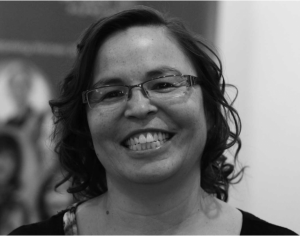
Meet Penny Carpenter, the first Aboriginal woman to become the Director of Finance at a tribal council, and the first woman to be part of the management team of Keewaytinook Okimakanak (KO). She is the director of KNET Services, the Indigenous-owned and operated telecommunications and digital services division of the KO First Nations Council in Sioux Lookout, Ontario.
Her colleagues and people in the community described her as a trailblazer. Her leadership and vision made KNET services the first owned and locally operated broadband network in the First Nations communities unlocking the opportunity of digital education in her community. As she stated in one of her interviews, “Bringing broadband to communities does not just bring technical skills… It brings health skills; it brings education skills, so people are able to remain in the community” (Garrick, 2015, para. 8). KNet broadband grew from serving five First Nation communities to supporting over 50 First Nations in Ontario, including a joint venture with northern Quebec and Manitoba to provide band satellite, and network to organizations in Sioux Lookout and Thunder Bay (http://www.wawataynews.ca/home/enterprising-first-nations-women-honoured).
She is an inspirational force for many women. Her contribution to the community helps close the digital divide in education caused by factors such as socioeconomic status and geographical location. Moreover, her research is focused on education and social justice in the First Nations communities. She has co-authored several papers highlighting digital innovations and using information communication technologies (ICT) in education and life-long learning in remote First Nations. Below are examples of papers she co-authored:
https://ineducation.ca/ineducation/article/view/266
https://journals.brandonu.ca/jrcd/article/view/1001/228
http://firstmile.ca/wp-content/uploads/2015/03/2014-Beaton-CSSE-Final-paper.pdf
Women leaders like Penny Carpenter is paving the way for others to have the opportunity to learn and enhance their knowledge through her work in education and technology. She is a role model not only to First Nation communities but also for women of every nation.
Thanky you Sharon for sharing your findings. I agree with you, she is a role model.
Her work is really interesting. I appreciate people who contribute to the community and affect the digital divide positively with their work 🙂
Great find Sharon.
The quote you included regarding broadband allowing residents to remain in the community is an excellent one. It certainly adds some perspective to the importance of accessibility to digital realms.
Here’s another resource for you regarding the development of the broadband network you mention in your post.
http://firstmile.ca/wp-content/uploads/2015/03/2007-November-VideoCom.pdf
Owen.
Thank you, Owen, for sharing this article on the broadband network. It underscores the importance of technology and its use in connecting people. My take-away from the article you shared is more work needs to happen to shift the mindset of the people to use and take advantage of the broadband network. It is a slow process. However, in recent studies of KNET services, it seems the adoption rate is increasing from the communities to use videoconferencing and online learning to improve their livelihood, health, well-being and education.
Hi Sharon, thanks for the post – Penny Carpenter’s contributions to helping create access is important work.
Hi Sharon,
What an excellent post, celebrating such an inspirational person in the field. I’m so encouraged by the work that women like Penny dedicate themselves to, particularly in light of the darker things happening in our world. We are all in this together so we speak for ourselves and each other by insisting, fiercely, to be heard, to contribute our unique spirit. Thank you for sharing Penny’s work with us.
Sue
Hi Sharon, Thank you for highlighting the incredible Penny Carpenter! I am grateful to have read about her work and learn more about issues of digital access in remote First Nations communities. Historical legacies, colonization and continued systemic marginalization of Indigenous communities across Canada, and throughout the world have resulted in immense inequities – I truly appreciate Penny’s perspective on the interconnected issues that emerge from the digital divide – a lack of broadband also impacts health, wellness, education, access to information, income generation activities, as well as ability to remain in one’s community and land. I thoroughly learned from reading “A critical understanding of adult learning, education and training using information and communication technologies (ICT) in remote First Nations” – specifically, about how access to technology can have such a meaningful impact on one’s material living conditions in terms of learning, training and general well-being within the context of remote First Nations communities.
Thanks, Sanjay, for your feedback. Her work is inspiring. You are correct that there are more issues of inequities to tackle, including in the education realm, and Penny’s actions and her likes in the First Nation Communities are paving the way to help close the gap.